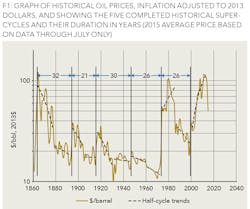Oil price super-cycles
EXAMINING CYCLICAL BEHAVIOR AND MIDPOINT CHARACTERISTICS
STEPHEN GUILLOT, GUTHRIE, OK
THERE ARE CLEARLY-DEFINED oil price super-cycles that have existed since the dawn of the "Age of Oil". These super-cycles have historically lasted an average of 27 years, with a minimum period of 21 years and a maximum of 32 years. Continuation of the cyclical behavior going forward from the current time, where the midpoint of the super-cycle was recently passed, means that we are entering a period of lower prices in which real oil prices will decline over the next decade or more.
A plot of inflation-adjusted oil prices from the dawn of the age of oil (1859) until present shows that there have been definite price cycles of similar length and similar character. A plot of inflation-adjusted annual average oil prices since 1859 is presented in Figure 1, with the beginning of each super-cycle marked with a vertical line and the super-cycle length shown in years. The point at which a new super-cycle begins is defined as where the steepest increase in oil price occurs, making what is now often referred to as a V-shaped recovery, from the lowest price at the end of the super-cycle.
These super-cycles exhibit the following characteristics:
- Sharp upward price spikes at the beginning of each super-cycle
- One or two additional upward spikes in the first half of each super-cycle, within 8-9 years of the first spike
- A mid-cycle price crash
- Price collapse at the end of each cycle followed by rapid recovery and the upward spike marking the beginning of the next super-cycle
- Lower price volatility and declining real prices in the second-half of each super-cycle
Price trends for each half-cycle are plotted as dotted lines in Figure 1 demonstrating the declining real prices seen in the second half of each price super-cycle. In all super-cycles, except for one, the lowest annual price was in the last year of the super-cycle. The lone possible exception to this was the 1931 price crash caused by sudden oversupply following the discovery of the East Texas field, coinciding with suppressed demand because of the Great Depression.
Some oil price prognosticators have compared the current oil bust to the 1985-86 bust. These two events are at the same point within their super-cycles: the midpoint. The precipitous price drop at the end of 1985 and early 1986 was the midpoint of the previous super-cycle which ended in late 1999, and occurred exactly 29 years before the most recent price crash that started late last year, which is within the range of durations of historical super-cycles as defined.
The similarity between the two price crashes (1985-86 and 2014-15) is striking. Both of them were driven by Saudi attempts to regain market share and to abandon their historical role as the OPEC swing producer. Artificial controls on actual quantities supplied to the market propped up prices beyond where they should have been, and there was a growing gap between demand and production capacity. This "price bubble" encouraged continued investment in oil projects at unsustainable levels until deployment of additional capacity created excess productive capacity and caused the bubble to burst.
Likewise, some prognosticators have compared the current bust to the 1998 and 2008 price crashes and in turn predict a V-shaped recovery as occurred in those cases. This is not supported by past history. V-shaped recoveries have not occurred at the middle of the price super-cycle. The only possible exception to this was in 1931 which was a weak one at best and occurred only after oil prices reached their all-time low point in real terms - a truly exceptional event. The 1998 crash occurred at the end of a super-cycle, and the 2008 price crash was well within the first half of the super-cycle during a period of expanding demand and limited production growth. It was caused largely by the global economic crisis, and it preceded significant US resource play production.
In contrast, mid-cycle busts are the culmination of years of developing increased production capacity coinciding with demand destruction, both caused by the high prices in the first half of the cycle. In addition to the 1931 crash, other examples of these are the 1905, 1985-86 and 2014-15 price crashes. The 1905 crash occurred after the 1901 Spindletop discovery which opened the door for development of prolific Gulf Coast oil fields. In the years preceding the 1985-86 bust significant non-OPEC production capacity was brought online which competed with the Saudis for market share, primarily from the Alaska North Slope, the North Sea and Mexico. In the most recent bust, significant additional production capacity came from US resource play development. These new sources took time to develop but, when fully realized, were significant enough to quickly move markets from undersupply to surplus.
Mid-cycle price crashes are also affected by demand destruction, with notable examples being the Great Depression, the reduction in US gasoline consumption brought on by the adoption in 1975 of the "CAFE" standards, which suppressed demand in the US over the decade leading up to the 1985-86 crash, and demand destruction from higher oil prices and slower economic growth in the US and China in recent years.
In their 2012 paper 'Super-cycles of commodity prices since the mid-nineteenth century', Erten and Ocampo present evidence of commodity "super-cycles", which include all non-fuel commodities. Their first recognized super-cycle begins in 1894 which is the beginning of the second oil price super-cycle in Figure 1. However, they postulate that there are only two super-cycles between 1894 and 1971, as opposed to my hypothesis of three super-cycles between 1894 and 1973. The first of their two super-cycles ends in 1932, a year after the mid-cycle price collapse by my definition of oil-price super-cycles. Their next cycle is from 1971 to 1999, which is very close to one of my defined cycles (1973-1999). Each of their cycles has an early upward phase and a late downward price trend, which is clearly exhibited in the last two oil price super-cycles.
In a later presentation to the IMF, Ocampo presents an analysis of price cycles for oil that matches my defined cycles, with the exception of 1894-1947, which he defines as one cycle of much longer duration. I define this period as two cycles of a duration almost identical to my later and earlier cycles based on relative compliance with the five criteria mentioned above. By my definition of the cycles, with an average cycle length of 27 years and not much deviation in that duration, we are currently just past the midpoint of the cycle where we have entered a period of low and relatively stable oil prices that will decline in real terms until the beginning of the next cycle.
What are the conditions that will cause this trend to continue? We have the perfect mechanism to do this, in the form of the US resource plays and the resource play potential that exists in other countries. In the US we have a multitude of plays in varying geographical areas, each with its own gas-to-liquids ratio, threshold price at which development is attractive, and access to market. These resources are, in turn, leased by hundreds of smaller companies, each with its own development strategy, financial situation and access to capital. There are other countries that have this same potential who will exploit their resources less aggressively than America has, but this additional supply will develop over time resulting in even more price stability.
These are not the mega-projects of the past that require huge capital investment, years of lead time, are so large that they can only be done by relatively few oil companies, and cannot be stopped once started. They are thousands of individual projects that are entirely independent of each other and can be started or stopped relatively quickly. If prices rise, more drilling will be spurred and production will quickly be on line, increasing supply and moderating prices, which in turn, will discourage drilling, creating a series of mini-cycles that will prevent prices from rising significantly. Along the way, there will be additional technological advances and operational optimizations that will improve project economics and in turn create more supply at lower prices. In addition, the US will have more diversity of and security of supply. This should dampen the effects of geopolitical events until such time that the US begins to import more oil and OPEC regains some ability to influence prices.
The "reference case" in the recent US oil production forecast released by the Energy Information Agency predicts that US production will increase gradually over the next few years until 2020, at which point "tight oil production declines, as drilling moves to more expensive areas". However, the reference case is based on oil being at $79/barrel (in 2013 dollars) in 2020. Their "low" case is based on a 2020 oil price of $64, which is high if we are entering a prolonged period of low and declining real prices, since the current price is lower than $64 and that is expected to decline in the second half of the super-cycle. Lower prices should cause deferral of projects with higher break-even prices, and delay the date at which that production peak is reached. In any event, the possibility of having a period of abundant supplies at relatively low prices is very believable out to the point at which, based on the length of previous super-cycles, we should be ready to begin the next one.
ABOUT THE AUTHOR
Stephen Guillot is a petroleum engineering consultant in Guthrie, Oklahoma. He is a 34-year active member of the Society of Petroleum Engineers, and is a registered petroleum engineer in the state of New Mexico. Guillot has worked in numerous engineering and management capacities at Texaco, Kinder Morgan CO2 and Chaparral Energy. He holds a bachelor's degree in civil engineering from the University of New Orleans and a master's degree in petroleum engineering from the University of Texas at Austin.


